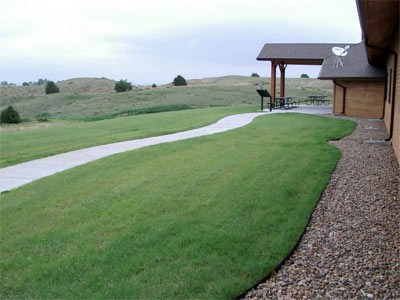Buffalo Grass
What is Buffalo Grass?
Buffalo Grass is a Perennial Grass native to the great plains area. It is primarily located from Montana to Mexico. And it gets the name Buffalo Grass because it supported the great herds of buffalo that roamed the great plans.
Buffalo Grass may very well be the only true native turf grass for North America. And it is a strong grass that fits right into this nation. It is able to survive prolonged droughts and extreme temperatures. Excessive traffic and over use (primarily feeding) are some of the only incidents in which buffalo grass may receive harm from.
Buffalo Grass is not adapted to shaded sites or to sites that receive heavy traffic. Also, under intensive management Bermuda grass and other more aggressive grasses tend to replace Buffalo Grass in the lawn.
Roadsides, school grounds, parks, open lawn areas, golf courses, and cemeteries are good sites for Buffalo grass in central, west and north Texas. It is the ideal grass for those wanting a "native" landscape.
Buffalo Grass does offer many advantages for a Low Maintenance Turf and is gaining acceptance and popularity in other Southwest areas. Buffalo grass thrives in neutral or alkaline clay soil, even heavy clay soil. It is native to our short grass prairie region. Drought tolerance is its best feature. A lush Buffalo grass turf requires only 50% of the water requirements as does bluegrass and fescue. However, it will survive on a great deal less, going into dormancy that is readily broken by rainfall.

Maintenance.
Buffalo Grass is not a high maintenance turf grass. Mowing can be reduced to simply Once A Month, or even once a year for a natural looking landscape. No Fertilizer. Fertilizer is out of the question - as it is actually harmful to buffalo grass. The best thing that you can do to help this turf grass is to apply 1/2" to 3/4" of compost in the fall. This is a very Easy Going Turf Grass.
Establishing Buffalo Grass.
Buffalo grass can be established from pieces of sod or sod plugs not less than 2" square. These should be planted on a well prepared seedbed in about 18" rows. Plants can be spaced anywhere from 6" to 2' apart, depending on how quickly a complete cover is desired. The closer they are spaced, the sooner the ground will be covered. In digging up material for planting care should be taken to keep the roots moist as the plants die very quickly when the roots get dry. When planting, dig a hole deep enough to set the plants in so that the grass is above ground level. If the pieces of sod are covered with soil, they will die. The soil should be packed around the plants. Planting is best done in moist soil or where irrigation is available. The grass should be planted in early fall, spring or early summer, when moisture is favorable. Plants should be well watered after planting and as needed for several weeks, thereafter.
Common uses for Buffalo Grass.
- Home turf lawns.
- Playgrounds and recreation areas.
- Institutional turf.
- Golf courses, Fairways, and Roughs.
- Airfields.
- Highway and roadsides.
- Cemeteries.
Advantages of Buffalo Grass.
- Less mowing, watering, and no fertilizing.
- Excellent heat, drought, and cold tolerance.
- Thrives in full sun.
- Tolerates dry, clay, and compacted soil.
- Few insect and disease problems.
- Very little thatch accumulation.
Disadvantages of Buffalo grass.
- Some people prefer a darker green color.
- Does not grow in dense shade.
- Does not grow on poorly drained or sandy soils.
- Weeds can be a problem.
- Greens up later in the spring and goes dormant after the first fall frost.
Mowing Buffalo grass
Buffalo grass does not require frequent mowing unless it is watered frequently and fertilized excessively. It tolerates a wide range of mowing heights and because it is naturally low growing (4 to 8 inches), it may not have to be mowed at all for some uses.
Home Mowing: 2-3 inches.
Golf courses: 1 inch.
Low maintenance parks, grounds: 3 inches or higher
Natural areas: None except for spring clean-up when growth initiates
Common causes of Weeds in Buffalo grass
- Frequent watering.
- Early season watering.
- Extremely short mowing.
- Too much fertilizer.
- Fertilizing too early in the season.
It is better to tolerate a few weeds that occur in nature rather than expecting a totally weed-free Buffalo Grass turf.
Management Summary
Requirements
Grows best in full sun. Should have at least 6 to 8 hours per day of direct sunlight. Good soil drainage is essential. Will grow well in clay soil but is not suited for sandy soils.
Planting
June and July are the best months to plant Buffalo Grass. April and May if irrigation is not available. 1 to 2 lbs of seed per 1,000 square feet.
Mowing
2 to 3 inches for most lawns. Frequency is affected by amount of watering and fertilizing.
Watering
Deep soak the soil every 2 weeks during summer droughts. Spring watering should be limited to a few deep waterings for the entire season.
Fertilizing
Early June is best. 1 to 2 pounds actual nitrogen per 1,000 square feet a year. Less on low maintenance and natural areas.
Weeds
Avoid frequent watering, short mowing, and over fertilizing.
